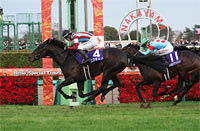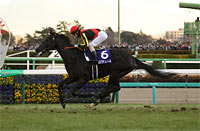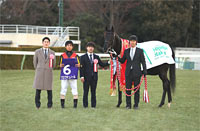Hopeful Stakes (G1) - Data Analysis
Key 2-year-old G1 race presents candidates for success in 2018
Like the Osaka Hai in April, the Hopeful Stakes was elevated to G1 status from this year. Originally known as the “Radio Tampa Hai Sansai Himba Stakes,” it was first held at Hanshin Racecourse in 1984, as a turf 1,600m race for fillies only. The race conditions and name were then changed several times, and between 2006 and 2013 it was called the “Radio Nikkei Hai Nisai Stakes.” Finally, the race name was changed to its present form in 2014, when it was contested on the 2,000m turf course at Nakayama. In the 31 times the race has been held so far, 27 of the 93 Top 3 finishers have gone on to win JRA G1 titles. In other words, this is a “career-making race” that will no doubt continue to produce a succession of star horses in the future. This time, let’s analyze some key features shared by successful runners in the Hopeful Stakes, based on results over the last 10 years (including 2007-2013, when it was held at Hanshin Racecourse).
Check career starts and track record
Looking first at aggregate performances of runners over the last 10 years in terms of their total career starts to date, those with only "1" career start have amassed an excellent record of success including a Top 3 ratio of 36.8%. Coming to this race straight after winning the debut outing would seem a good platform for high expectation. [Table 1]
[Table 1] Performance by total career starts to date (last 10 years)
| Total career starts to date |
Performance
[1st-2nd-3rd-4th or lower] |
Win ratio |
Top 2 ratio |
Top 3 ratio |
| 1 |
3-1-3-12 |
15.8% |
21.1% |
36.8% |
| 2 |
4-2-6-36 |
8.3% |
12.5% |
25.0% |
| 3 |
1-3-1-26 |
3.2% |
12.9% |
16.1% |
| 4 |
1-1-0-15 |
5.9% |
11.8% |
11.8% |
| 5 |
1-2-0-10 |
7.7% |
23.1% |
23.1% |
| 6 |
0-1-0-3 |
0% |
25.0% |
25.0% |
| 7 |
0-0-0-3 |
0% |
0% |
0% |
| 8 |
0-0-0-1 |
0% |
0% |
0% |
Of those with two or more career starts, no runner lacking Top 3 experience in “JRA races in a one-win class or higher” has won this race; in fact, horses in this category have only managed a Top 3 ratio of 6.6%. We should probably lower our expectations of runners with two or more career starts if they have failed to finish in the Top 3 after winning their newcomer or maiden race. [Table 2]
[Table 2] Performance of runners with two or more career starts, by Top 3 experience in “JRA races in a one-win class or higher” (last 10 years)
| Experience |
Performance
[1st-2nd-3rd-4th or lower] |
Win ratio |
Top 2 ratio |
Top 3 ratio |
| Yes |
7-8-4-37 |
12.5% |
26.8% |
33.9% |
| No |
0-1-3-57 |
0% |
1.6% |
6.6% |
Condition of last race and finish last time out could be key
Of 30 Top 3 finishers over the last 10 years, nine had most recently competed in “JRA graded races.” Horses in this category have achieved excellent success ratios, including a Top 3 ratio of 36.0%. Our primary focus should be runners coming straight from JRA graded races. [Table 3]
[Table 3] Performance by condition of previous race (last 10 years)
| Condition of previous race |
Performance
[1st-2nd-3rd-4th or lower] |
Win ratio |
Top 2 ratio |
Top 3 ratio |
| JRA graded races |
3-4-2-16 |
12.0% |
28.0% |
36.0% |
| Other races |
7-6-8-90 |
6.3% |
11.7% |
18.9% |
Of those competing in “Other races” last time out, none with a finish of “4th or lower” in that race has finished in the Top 3 here. Runners coming straight from anything other than a JRA graded race seem likely to struggle in the Hopeful Stakes unless they managed a Top 3 finish in that race. [Table 4]
[Table 4] Performance by finish last time out when it was not a JRA graded race (last 10 years)
| Finish last time out |
Performance
[1st-2nd-3rd-4th or lower] |
Win ratio |
Top 2 ratio |
Top 3 ratio |
| In the Top 3 |
7-6-8-65 |
8.1% |
15.1% |
24.4% |
| 4th or lower |
0-0-0-25 |
0% |
0% |
0% |
“Final spurt” last time out is also important
Of 30 Top 3 finishers over the last 10 years, all except the 2007 winner Subject had been ranked “3rd or higher” in their estimated time over the final three furlongs last time out. By contrast, those ranked “4th or lower” have a measly Top 3 ratio of only 2.7%. When comparing the details of the previous race, we need to focus not only on the finish but also on the “final spurt.” [Table 5]
[Table 5] Performance by ranking in estimated time over the final three furlongs in the previous outing when it was a JRA race (last 10 years)
| Estimated time over final 3 furlongs last time out |
Performance
[1st-2nd-3rd-4th or lower] |
Win ratio |
Top 2 ratio |
Top 3 ratio |
| 3rd or higher |
9-10-10-68 |
9.3% |
19.6% |
29.9% |
| 4th or lower |
1-0-0-36 |
2.7% |
2.7% |
2.7% |
Inner- and outermost brackets produce little success
Turning next to performances by horse number since 2014, when the race was moved to the 2,000m turf course at Nakayama, eight of the nine Top 3 finishers in that time took to the field with numbers "6-11." Conversely, the numbers "12-17" have failed to produce a single Top 3 finisher, while horses with numbers "1-5" also have a Top 3 ratio of only 6.7%. Judging from trends in recent years, runners in the inner- and outermost brackets seem less likely to succeed. [Table 6]
[Table 6] Performance by horse number (last 3 years)
| Horse number |
Performance
[1st-2nd-3rd-4th or lower] |
Win ratio |
Top 2 ratio |
Top 3 ratio |
| 1 |
0-0-0-3 |
0% |
0% |
0% |
| 2 |
1-0-0-2 |
33.3% |
33.3% |
33.3% |
| 3 |
0-0-0-3 |
0% |
0% |
0% |
| 4 |
0-0-0-3 |
0% |
0% |
0% |
| 5 |
0-0-0-3 |
0% |
0% |
0% |
| 6 |
1-1-1-0 |
33.3% |
66.7% |
100.0% |
| 7 |
0-0-1-1 |
0% |
0% |
50.0% |
| 8 |
0-0-1-2 |
0% |
0% |
33.3% |
| 9 |
0-1-0-2 |
0% |
33.3% |
33.3% |
| 10 |
1-0-0-2 |
33.3% |
33.3% |
33.3% |
| 11 |
0-1-0-2 |
0% |
33.3% |
33.3% |
| 12 |
0-0-0-3 |
0% |
0% |
0% |
| 13 |
0-0-0-3 |
0% |
0% |
0% |
| 14 |
0-0-0-2 |
0% |
0% |
0% |
| 15 |
0-0-0-1 |
0% |
0% |
0% |
| 16 |
0-0-0-1 |
0% |
0% |
0% |
| 17 |
0-0-0-1 |
0% |
0% |
0% |
| 1-5 |
1-0-0-14 |
6.7% |
6.7% |
6.7% |
| 6-11 |
2-3-3-9 |
11.8% |
29.4% |
47.1% |
| 12-17 |
0-0-0-11 |
0% |
0% |
0% |
Poor showing from runners with no experience of wins outside local racecourses
Of the last 10 winners, all except Subject in 2007 had experience of winning “turf races over distances of 1,600m or more at the four major racecourses (Tokyo, Nakayama, Kyoto, Hanshin).” Horses without this experience have a poor Top 3 ratio of 15.2%, and have hardly had a sniff of success in the last three years since 2014, with figures of [0-1-0-19] (Top 3 ratio 5.0%). We should not be expecting great things from runners with experience of wins only in dirt races and/or short-distance races, or those with no experience of wins outside local racecourses. [Table 7]
[Table 7] Performance by experience of winning "turf races over 1,600m+ at the four major racecourses (Tokyo, Nakayama, Kyoto, Hanshin)" (last 10 years)
| Experience of winning |
Performance
[1st-2nd-3rd-4th or lower] |
Win ratio |
Top 2 ratio |
Top 3 ratio |
| Yes |
9-7-7-67 |
10.0% |
17.8% |
25.6% |
| No |
1-3-3-39 |
2.2% |
8.7% |
15.2% |
Seek out the winner!
All recent winners had most recently contested a turf race over 1,800m or more
All of the last nine winners had most recently contested turf races over distances of 1,800m or more. As such, we shouldn't pin too much hope on runners coming straight from dirt races or turf races less than 1,800m. Other features shared by these nine are that their estimated time over the final three furlongs last time out was ranked 3rd or higher, they entered the race with horse numbers 1-10, and they had experience of winning turf races over distances of 1,600m or more at the four major racecourses (Tokyo, Nakayama, Kyoto, Hanshin). Our focus should be on runners with the fewest reasons for uncertainty, including the trends highlighted in Tables 1 to 4 above. [Table 8]
[Table 8] "Course last time out", "Ranking in estimated time over final three furlongs last time out", "Horse number" and "Highest finish in races over distances of 1,600m or more at the four major racecourses (Tokyo, Nakayama, Kyoto, Hanshin)" of winning horses (last 9 years)
| Year |
Winner |
Course last
time out |
Ranking in estimated time over
final 3 furlongs last time out |
Horse number |
Highest finish in races over
1,600m+ at 4 major RC |
| 2008 |
Logi Universe |
Sapporo, turf 1,800m |
1st |
6 |
1st (Hanshin, 2yo newcomer) |
| 2009 |
Victoire Pisa |
Kyoto, turf 2,000m |
3rd |
3 |
1st (Kyoto Nisai Stakes, etc.) |
| 2010 |
Danon Ballade |
Kyoto, turf 2,000m |
3rd |
8 |
1st (Kyoto, 2yo newcomer) |
| 2011 |
Adam’s Peak |
Hanshin, turf 2,000m |
1st |
2 |
1st (Hanshin, 2yo newcomer) |
| 2012 |
Epiphaneia |
Kyoto, turf 2,000m |
1st |
7 |
1st (Kyoto Nisai Stakes, etc.) |
| 2013 |
One and Only |
Tokyo, turf 1,800m |
3rd |
1 |
1st (Hanshin, 2yo maiden) |
| 2014 |
Shining Lei |
Kyoto, turf 2,000m |
1st |
10 |
1st (Kyoto, 2yo newcomer) |
| 2015 |
Hartley |
Tokyo, turf 2,000m |
1st |
6 |
1st (Tokyo, 2yo newcomer) |
| 2016 |
Rey de Oro |
Nakayama, turf 2,000m |
1st |
2 |
1st (Habotan Sho, etc.) |
(Masaya Ibuki) |

- Preview
- Barrier draw
- Past performances of runners

- News
- Race result
- Video
- 2025 English

- 2024 English

- 2023 English

- 2022 English

- 2021 English

- 2020 English

- 2019 English

- 2018 English

- 2017 English

- 2016 English

- 2015 English

- 2014 English

- 2013

- 2012

- Photo Gallery
2025 Winner: Lovcen


2024 Winner: Croix du Nord


|



















